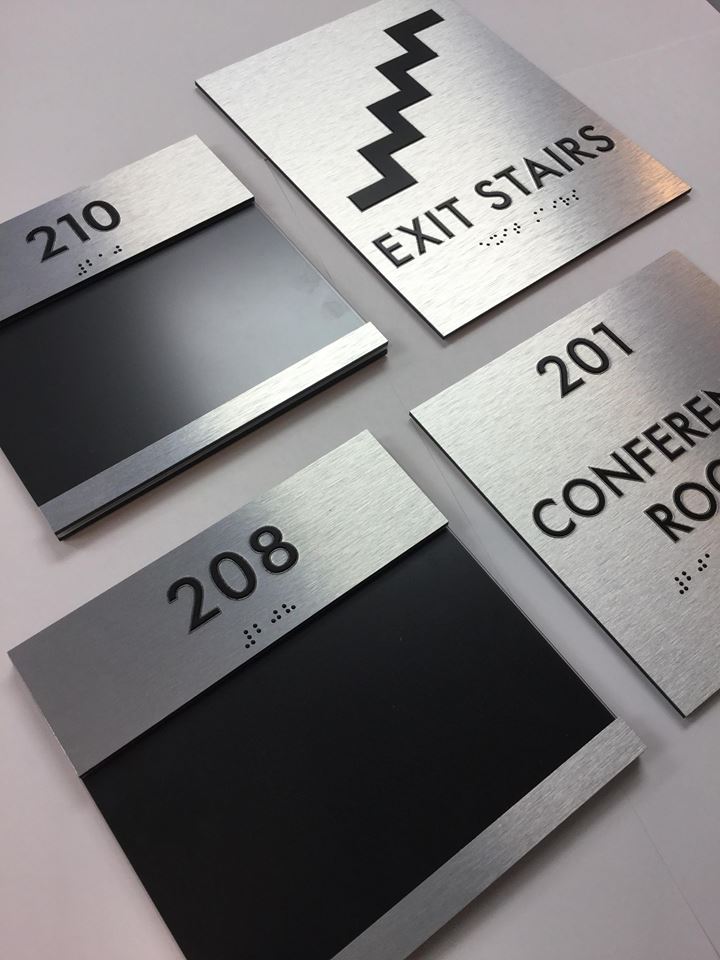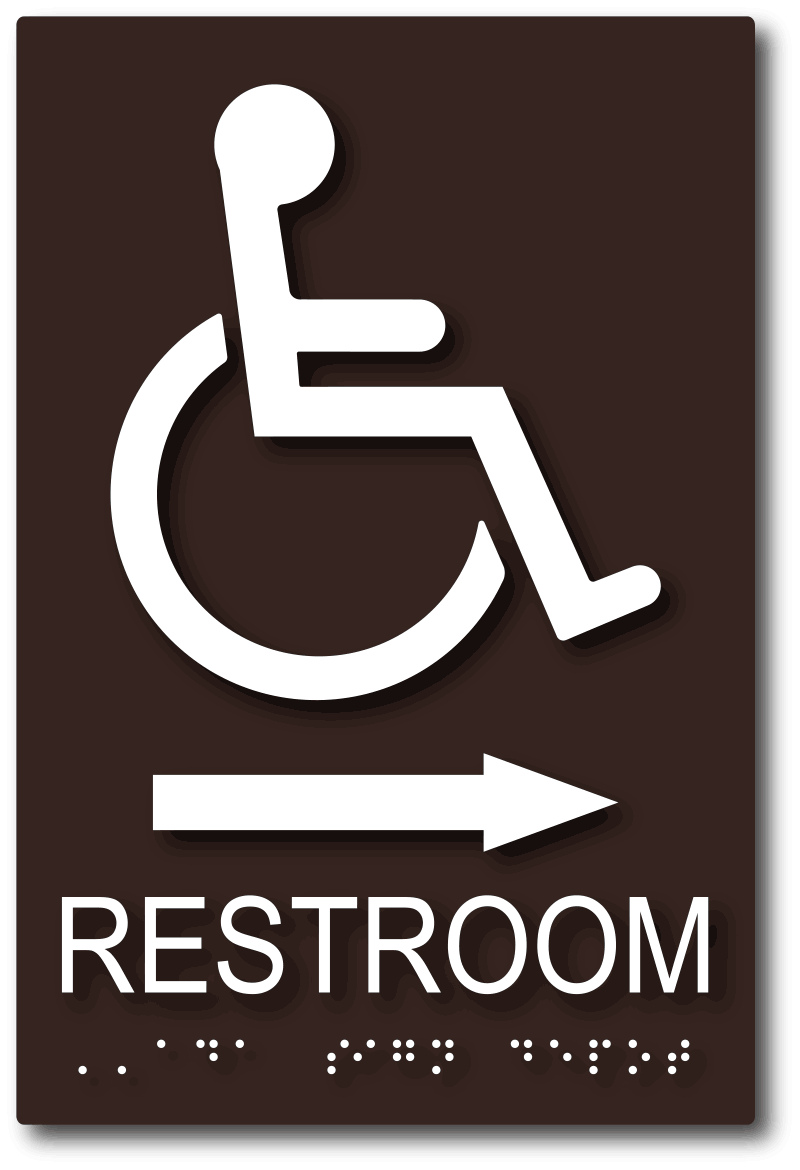The Function of ADA Signs in Following Access Standards
The Function of ADA Signs in Following Access Standards
Blog Article
Checking Out the Secret Functions of ADA Signs for Enhanced Accessibility
In the realm of access, ADA indications offer as silent yet effective allies, making certain that spaces are accessible and comprehensive for people with impairments. By incorporating Braille and tactile aspects, these signs break obstacles for the visually impaired, while high-contrast shade schemes and readable typefaces cater to varied aesthetic needs.
Value of ADA Compliance
Guaranteeing conformity with the Americans with Disabilities Act (ADA) is important for cultivating inclusivity and equal accessibility in public areas and offices. The ADA, enacted in 1990, mandates that all public facilities, employers, and transport solutions accommodate individuals with handicaps, guaranteeing they appreciate the exact same rights and possibilities as others. Conformity with ADA requirements not only satisfies legal commitments but also enhances an organization's credibility by showing its commitment to diversity and inclusivity.
One of the vital aspects of ADA compliance is the implementation of easily accessible signage. ADA indicators are made to make sure that people with handicaps can conveniently browse via buildings and spaces. These signs need to follow details standards pertaining to dimension, typeface, shade contrast, and placement to guarantee visibility and readability for all. Properly implemented ADA signage aids remove obstacles that people with impairments typically come across, thus promoting their independence and self-confidence (ADA Signs).
Additionally, adhering to ADA guidelines can reduce the threat of potential penalties and legal repercussions. Organizations that fall short to abide with ADA standards may face legal actions or charges, which can be both economically burdensome and harmful to their public image. Hence, ADA compliance is indispensable to promoting a fair atmosphere for every person.
Braille and Tactile Elements
The unification of Braille and tactile components into ADA signs embodies the principles of access and inclusivity. These functions are crucial for individuals that are blind or visually impaired, enabling them to browse public rooms with higher freedom and confidence. Braille, a responsive writing system, is crucial in providing composed details in a layout that can be quickly regarded through touch. It is normally positioned beneath the matching message on signs to guarantee that individuals can access the details without visual support.
Responsive components extend beyond Braille and consist of elevated personalities and icons. These elements are created to be discernible by touch, enabling individuals to identify area numbers, toilets, leaves, and various other crucial locations. The ADA establishes certain guidelines concerning the size, spacing, and positioning of these responsive aspects to optimize readability and ensure uniformity throughout different environments.

High-Contrast Color Pattern
High-contrast shade schemes play a pivotal function in enhancing the presence and readability of ADA signage for people with aesthetic impairments. These systems are vital as they take full advantage of the difference in light reflectance in between message and background, making certain that indications are conveniently discernible, even from a distance. The Americans with Disabilities Act (ADA) mandates using details color contrasts to suit those with restricted vision, making it an important aspect of conformity.
The efficacy of high-contrast colors depends on their capability to stand out in different lights conditions, consisting of dimly lit environments and locations with glare. Normally, dark text on a light background or light message on a dark history is utilized to attain optimal contrast. For circumstances, black text on a yellow or white history offers a plain aesthetic difference that helps in fast acknowledgment and comprehension.

Legible Fonts and Text Dimension
When considering the design of ADA signage, the selection of understandable fonts and ideal message size can not be overemphasized. These components are important for making certain that signs come to individuals with visual disabilities. The Americans with Disabilities Act (ADA) mandates that typefaces have to be sans-serif and not italic, oblique, script, highly decorative, or of unusual form. These requirements help make certain that the message is conveniently legible from a range which the characters are appreciable to diverse audiences.
The size of the message additionally plays a crucial function in availability. According to ADA guidelines, the minimum message elevation ought to be 5/8 inch, and it ought to increase proportionally with watching range. This is particularly important in public spaces where signage demands to be checked out rapidly and properly. Uniformity in text dimension adds to a cohesive aesthetic experience, helping individuals in navigating settings effectively.
In addition, spacing in between lines and letters is important to readability. Ample spacing avoids personalities from appearing crowded, boosting readability. By adhering to these criteria, developers can dramatically improve access, making sure that signs serves its desired purpose for all people, no matter of their visual capacities.
Effective Placement Approaches
Strategic placement of ADA signs is important for making the most of availability and making sure conformity with legal requirements. Effectively positioned click indications lead individuals with impairments successfully, facilitating navigation in public areas. Trick factors to consider include exposure, distance, and elevation. ADA standards specify that indicators should be mounted at a height between 48 to 60 inches from the ground to ensure they are within the line of sight for both standing and seated individuals. This common elevation array is essential for inclusivity, enabling wheelchair users and people of differing elevations to accessibility details easily.
In addition, indications must be positioned adjacent to the lock side of doors to permit simple recognition prior to entry. Consistency in indication placement throughout a center enhances predictability, reducing complication and improving total individual experience.

Final Thought
ADA indications play a crucial role in advertising access by integrating attributes that deal with the needs of people with handicaps. Incorporating Braille and responsive aspects makes certain vital details comes to the aesthetically damaged, while high-contrast color pattern and readable sans-serif typefaces enhance presence throughout numerous lighting conditions. Efficient positioning strategies, such as suitable installing elevations and critical locations, further help with navigation. These aspects jointly cultivate a comprehensive environment, underscoring the significance of ADA compliance in making sure equivalent accessibility for all.
In the world of availability, ADA indications serve as silent yet effective allies, making certain that rooms are inclusive and navigable for individuals with disabilities. The ADA, enacted in 1990, mandates that all public centers, companies, and transportation services suit people with impairments, ensuring they enjoy the very same legal rights and chances as others. ADA Signs. ADA signs are designed to make certain that go to these guys people with specials needs can quickly navigate via areas and structures. ADA guidelines state that indications must be placed at get more an elevation in between 48 to 60 inches from the ground to guarantee they are within the line of sight for both standing and seated people.ADA indications play a vital duty in promoting accessibility by incorporating features that resolve the demands of people with disabilities
Report this page